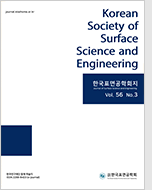
- Past Issues
- e-Submission
-

2021 Impact Factor 1.766
5-Year Impact Factor 1.674
Editorial Office
- +82-2-563-0935
- +82-2-558-2230
- submission@kssse.or.kr
- https://www.kssse.or.kr/

2021 Impact Factor 1.766
5-Year Impact Factor 1.674
The Korean Society of Surface Science and Engineering 2023;56(2):115-124. Published online: May, 2, 2023
DOI : /10.5695/JSSE.2023.56.2.115
Anodization is an electrochemical process that electrochemically converts a metal surface into an oxide layer, resulting in enhanced corrosion resistance, wear resistance, and improved aesthetic appearance. Local anodization, also known as selective anodization, is a modified process that enables specific regions or patterns on the metal surface to undergo anodization instead of the entire surface. Several methods have been attempted to produce oxide layers via localized anodic oxidation, such as using a mask or pre-patterned substrate. However, these methods are often intricate, time-consuming, and costly. Conversely, the direct writing or patterning approach is a more straightforward and efficient way to fabricate the oxide layers. This review paper intends to enhance our comprehension of local anodization and its potential applications in various fields, including the development of nanotechnologies. The application of anodization is promising in surface engineering, where the anodic oxide layer serves as a protective coating for metals or modifies the surface properties of materials. Furthermore, anodic oxidation can create micro- and nano-scale patterns on metal surfaces. Overall, the development of efficient and cost-effective anodic oxidation methods is essential for the advancement of various industries and technologies.
Keywords Local anodization; Mask; Patterned substrate; Direct writing; Oxide layer.